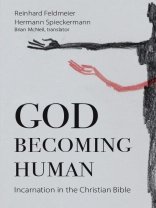The incarnation–the act of God assuming mortal flesh through Jesus Christ–reveals God’s radical love for a world marked by the rebellion of the created against their creator. God becomes human to create life and restore the disrupted divine-human relationship. This doctrine is thus the theme of the Christian faith par excellence. However, the incarnation does not begin with its ultimate realization in Jesus Christ; that single event is preceded by a long history of a God who continually reunites with his people to lead them from death to life, from bondage to freedom.
God Becoming Human pursues the astonishing arc of the incarnation, chronicling the varying ways Scripture recounts the divide between God and the creatures of his likeness as well as the diverse expressions the text gives regarding the desire for reconciliation. As the expectations of an existing intermediary that can somehow bridge this gap between God and humans dwindle throughout the Old Testament, hope is increasingly placed on new forms of closeness to God. The closeness made possible by Jesus Christ receives a wide range of interpretations by New Testament witnesses and is continued by a rich chorus that culminates in the early church with the theology of the incarnation.
Reinhard Feldmeier and Hermann Spieckermann invite readers to see that the doctrine of the incarnation, the pinnacle of the scriptural saga of redemption, reveals that God’s ultimate purpose in dealing with creation was to become human. As narrated in the story of the fall, if paradise was lost because humanity wanted to emulate God, the one reconciled with God through Christ is now given the opportunity–and challenge–to become a child of God. In accordance with the One who descended from the heavenly throne, one must precisely lower oneself and thus fully embrace one’s created humanness. It is through the flesh that the created and their creator are joined; there is no other path to unity.
Daftar Isi
Foreword
Translator’s Note
Abbreviations
Introduction: The Aims of This Work
A. The Prehistory of the Incarnation
1 In the Beginning
The Creator and His Problematic Image
2 Mediators of God’s Nearness
3 New Figures of God’s Nearness
4 At the Point of Transition
From Death to Life
B. Conceptions of Incarnation
1 The Galilean Man of God
From the Jesus of Memory to the Christ of Faith
2 Kyrios Jesus Christos
Paul on the One Who Became Human
3 The Proclaimer as the Proclaimed
The Synoptic Tradition
4 The Incarnation of the Logos
The Johannine Tradition
5 Christ and the Christians
The Early Christian Testimony
Conclusion: The God Who Became Human–and Our Becoming Human
Tentang Penulis
Reinhard Feldmeier is Professor of New Testament, Georg-August-University, Göttingen.Hermann Spieckermann is Professor of Old Testament at the Georg-August-University of Göttingen.







![Sampul Brian Schrag & Julisa Rowe: Community Arts for God's Purposes [Chinese] 貼近神心意的社群藝術 Sampul Brian Schrag & Julisa Rowe: Community Arts for God's Purposes [Chinese] 貼近神心意的社群藝術](https://static.worldofdigitals.com/thumb_webp/740/9781645083740.webp)




